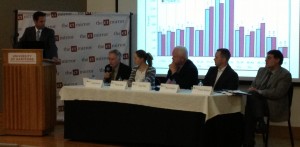The mayors of two of Connecticut’s major cities – and their communities – had moments in the spotlight at the just-concluded annual meeting of the U.S. Conference of Mayors (USCM) in Washington, D.C.
Hartford Mayor Pedro E. Segarra won first place for medium/small cities in the organization’s 1st Annual National SummerYouth Jobs Challenge. The award honors the outstanding achievements in innovative partnerships between cities and local business and non-profit communities to help provide youth with meaningful summer job experiences.
Mayor Neil M. O’Leary accepted a first place award for Waterbury’s Kid’s Marathon Program. The organization gave six awards to mayors of cities with outstanding programs that encourage healthy weight through balanced diet choices and regular physical activity. As the top selection, Waterbury receives a $120,000 grant that will support the 2014 Kid’s Marathon Program, a partnership between the YMCA, City of Waterbury, Department of Education, Boys and Girls Club, Police Activity League (PAL) and Connecticut Association of Schools, aimed at introducing the sport of running to youth ages 7-12, over a 12-week period and at no charge to the participants.
Approximately 250 mayors, USCM business council members, USCM Workforce Development Council members and other workforce development professionals from major cities across the country attended the annual meeting. The award was presented to Hartford at Thursday morning’s plenary session, which included remarks by Segarra, Louisville Mayor G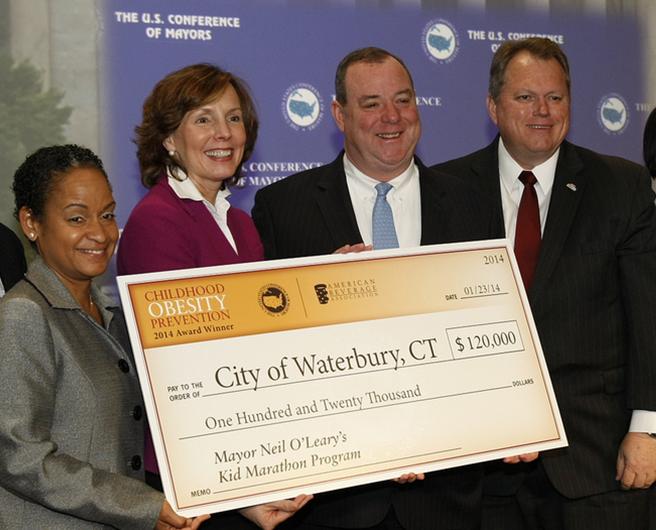 reg Fischer, U.S. Labor Secretary Thomas Perez and Wendy Spencer, CEO of the Corporation for National and Community Service.
reg Fischer, U.S. Labor Secretary Thomas Perez and Wendy Spencer, CEO of the Corporation for National and Community Service.
Since taking office in 2010, Segarra has invested regularly in youth employment programming, leverageing state and foundation funds to further expand work opportunities for young people. In 2013, the Mayor secured $1.25 million that put nearly half of the 2,056 youth in the region to work, officials said. Additionally, in conjunction with four other regional mayors, he spearheaded an “unsubsidized” youth employment campaign, aligned with the Obama administration’s Youth Jobs + effort, which resulted in an additional 208 employer-paid positions.
Segarra was joined at the mayor’s conference by Capital Workforce Partners President and CEO, Tom Phillips who was the 2012 President of the U. S. Conference of Mayor’s Workforce Development Council, and whose organization is instrumental in finding worksites and providing career competencies for over 2,000 youth in the North Central Connecticut region each summer.
Among the ten Connecticut Mayors registered to attend the conference in addition to Segarra and O’Leary were Bridgeport Mayor Bill Finch, Stratford Mayor John Harkins, West Haven Mayor Edward O’Brien, Trumbull Mayor Tim Herbst, Shelton Mayor Mark Lauretti, East Hartford Mayor Marcia Leclerc, Fairfield Mayor Michael Tetreau, and Stamford Mayor David Martin. The U.S. Conference of Mayors is the official nonpartisan organization of cities with populations of 30,000 or more. There are 1,399 such cities in the country today, and each city is represented in the Conference by its chief elected official.
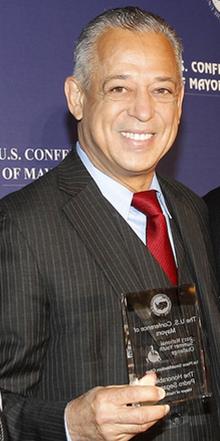 The Kid’s Marathon Program is designed to target city youth lacking in physical activity and good nutrition habits. Students run 1-2 miles, two or three times per week, completing a cumulative 26.2 mile marathon over the course of the program. They also receive positive and practical guidance on nutrition that helps foster long-term healthy eating behaviors. In 2013, the program’s first year, 438 students participated, with the culminating 1-mile run occurring at Crosby High School before a crowd of family, friends and supporters.
The Kid’s Marathon Program is designed to target city youth lacking in physical activity and good nutrition habits. Students run 1-2 miles, two or three times per week, completing a cumulative 26.2 mile marathon over the course of the program. They also receive positive and practical guidance on nutrition that helps foster long-term healthy eating behaviors. In 2013, the program’s first year, 438 students participated, with the culminating 1-mile run occurring at Crosby High School before a crowd of family, friends and supporters.
USCM also recognized Eugene Morton, a Hartford resident who participated in employment opportunities created through Segarra’s youth initiatives. A 2007 graduate of Hartford’s Sports and Medical Sciences Academy, Morton is a Marketing major at Central Connecticut State University with a 4.0 average. In 2013, he took advantage of a summer employment opportunity at St. Francis Hospital and Medical Center and was one of 13 college students who participated in the summer youth employment program offered at St. Francis Hospital and Medical Center in partnership with the Blue Hills Civic Association.
Mayor O’Leary and Waterbury were recognized with the first place award for their collaborative efforts on launching the Kid’s Marathon Program with the Rod Dixon Kid’s Marathon Foundation. The grant awards were divided into small, medium and large city categories, with first place and second place awards given in each category. Waterbury placed first in the “medium city” category; the second place finisher was Little Rock, AR. The grant program is the result of a partnership between USCM and the American Beverag e Association (ABA), to support and/or enhance mayors’ ongoing childhood obesity prevention programs in their cities. A total of $445,000 in grants was awarded to support both new and existing programs. Denver, CO and Dallas, TX (large cities) and York, PA and Monrovia, CA (small cities) were the other recipients.
e Association (ABA), to support and/or enhance mayors’ ongoing childhood obesity prevention programs in their cities. A total of $445,000 in grants was awarded to support both new and existing programs. Denver, CO and Dallas, TX (large cities) and York, PA and Monrovia, CA (small cities) were the other recipients.
Last fall, the U.S. Conference of Mayors and Partner America awarded Hartford Mayor Pedro E. Segarra their small business advocate of the year award. The USCM presented Segarra with the award during the Greater New England Minority Supplier Development Council Expo, at the Connecticut Convention Center. The organization credited Segarra for launching the iConnect storefront revitalization project, quickening the pace of city permit approvals, investing $500,000 in façade improvements and awarding over $100,000 to 16 local artists and small businesses. At the time, the mayor's office said the city has gained 134 small business and 200 jobs since 2010.
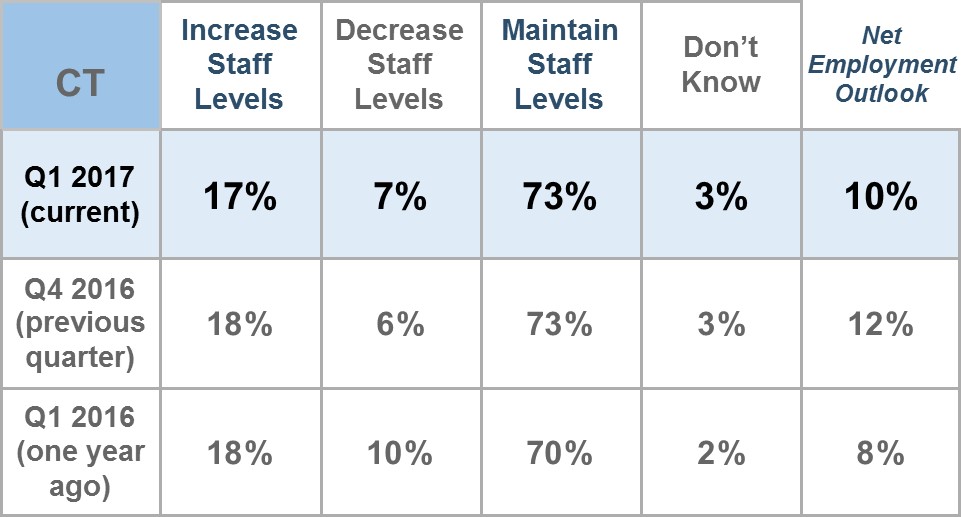 From January to March, 17 percent of Connecticut companies interviewed plan to hire more employees, while 7 percent expect to reduce their payrolls. Another 73 percent expect to maintain their current workforce levels and 3 percent are not certain of their hiring plans. This yields a Net Employment Outlook* of 10 percent.
From January to March, 17 percent of Connecticut companies interviewed plan to hire more employees, while 7 percent expect to reduce their payrolls. Another 73 percent expect to maintain their current workforce levels and 3 percent are not certain of their hiring plans. This yields a Net Employment Outlook* of 10 percent.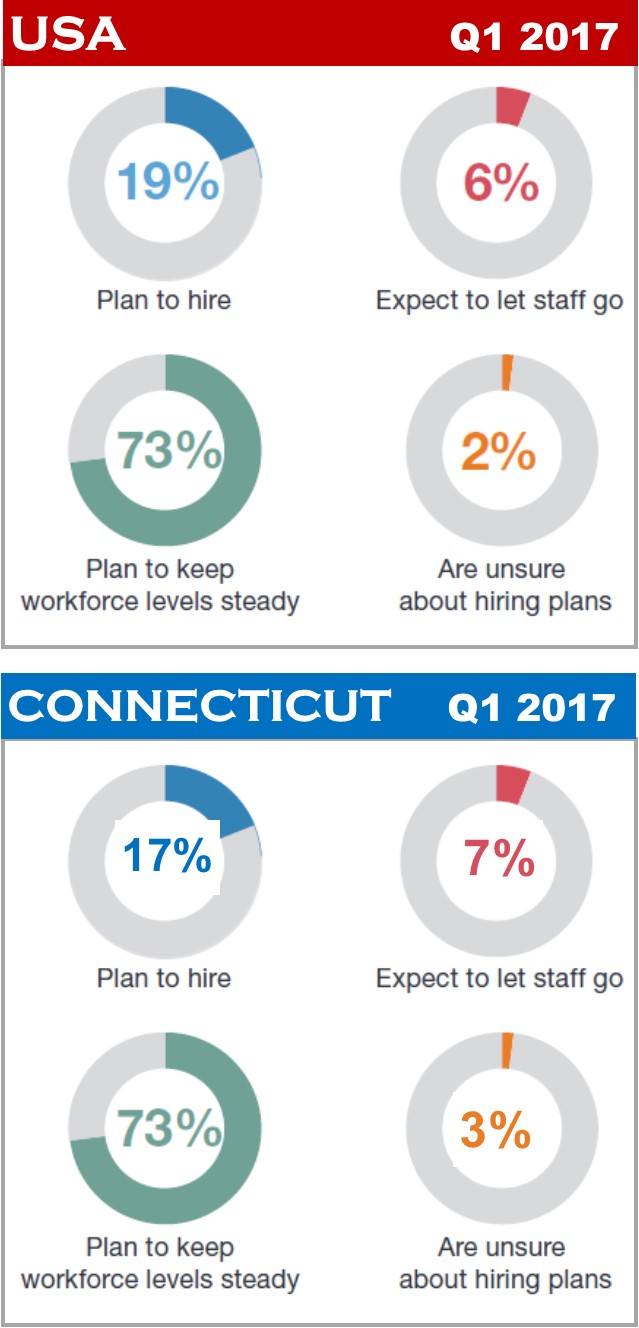 formation and Other Services plan to reduce staffing levels.
formation and Other Services plan to reduce staffing levels.


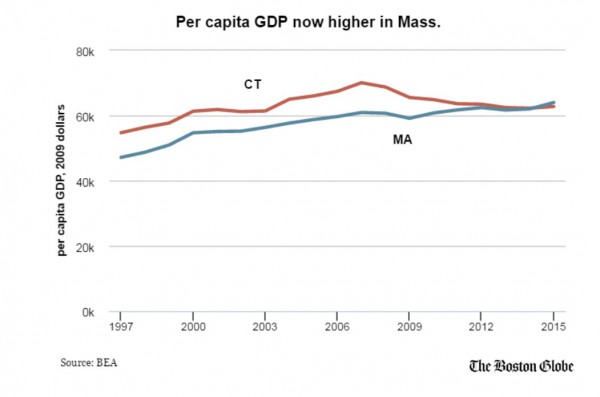 “The company will hire 14,000 new employees over the next 13 years,” the
“The company will hire 14,000 new employees over the next 13 years,” the 
 For the quarter just underway, job prospects appear best in Construction, Durable Goods Manufacturing, Transportation & Utilities, Wholesale & Retail Trade, Information, Financial Activities, Professional & Business Services, Education & Health Services, Leisure & Hospitality and Other Services. Employers in Nondurable Goods Manufacturing plan to reduce staffing levels, while hiring in Government is expected to remain unchanged, according to the projections.
For the quarter just underway, job prospects appear best in Construction, Durable Goods Manufacturing, Transportation & Utilities, Wholesale & Retail Trade, Information, Financial Activities, Professional & Business Services, Education & Health Services, Leisure & Hospitality and Other Services. Employers in Nondurable Goods Manufacturing plan to reduce staffing levels, while hiring in Government is expected to remain unchanged, according to the projections.
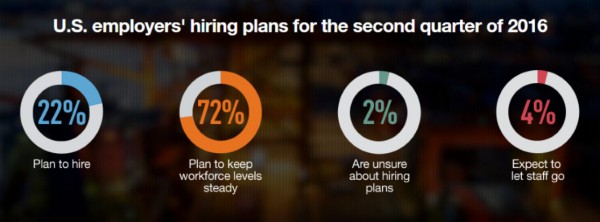
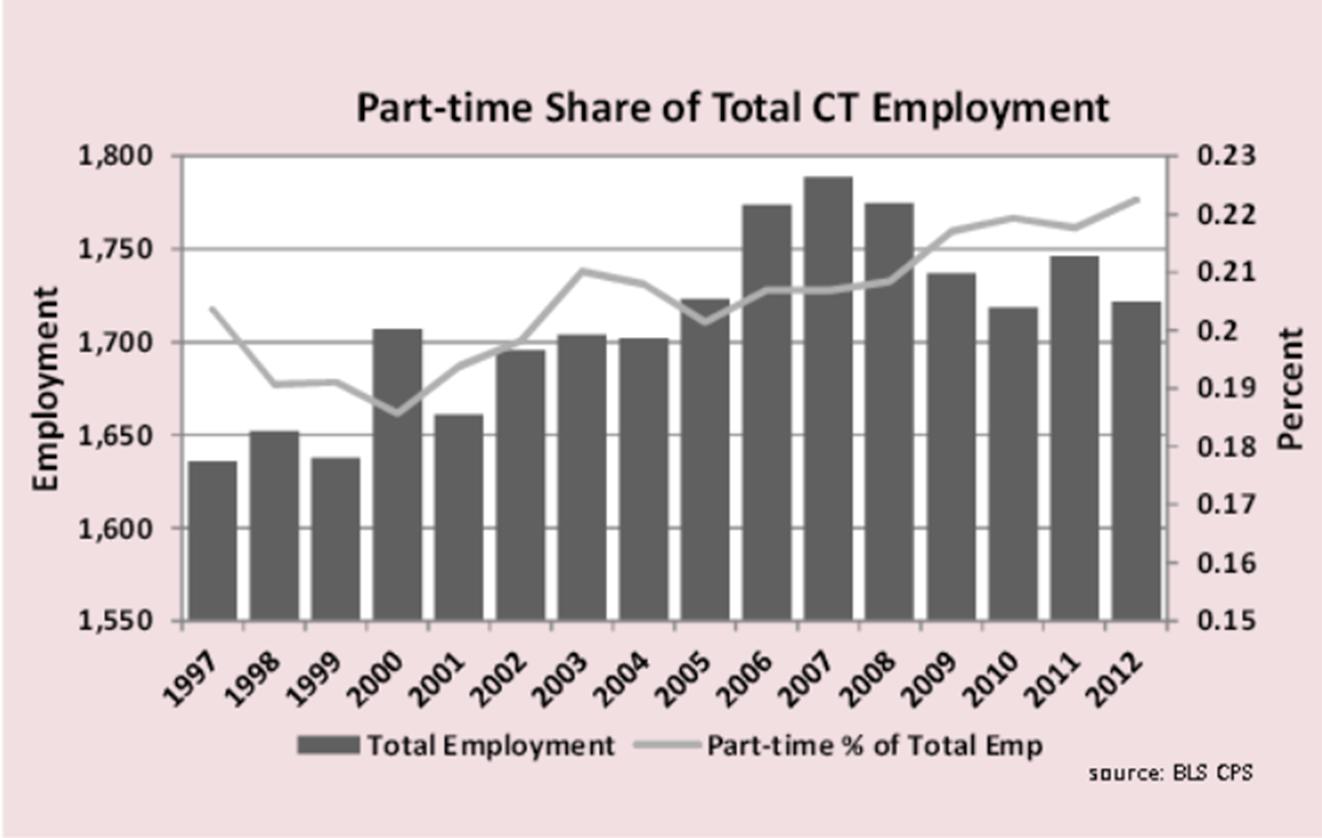
 a and the basis for the analysis. The breakdown of hours worked shows that Connecticut has less under 35 hours per week employment than other New England states but more than the Northeast region overall.
Part-time employment was 23.3% of all New England employment in 2012, higher than any other census division in the country. The other eight census divisions averaged 19.3% with the West- South Central division lowest at 16.4%.
a and the basis for the analysis. The breakdown of hours worked shows that Connecticut has less under 35 hours per week employment than other New England states but more than the Northeast region overall.
Part-time employment was 23.3% of all New England employment in 2012, higher than any other census division in the country. The other eight census divisions averaged 19.3% with the West- South Central division lowest at 16.4%.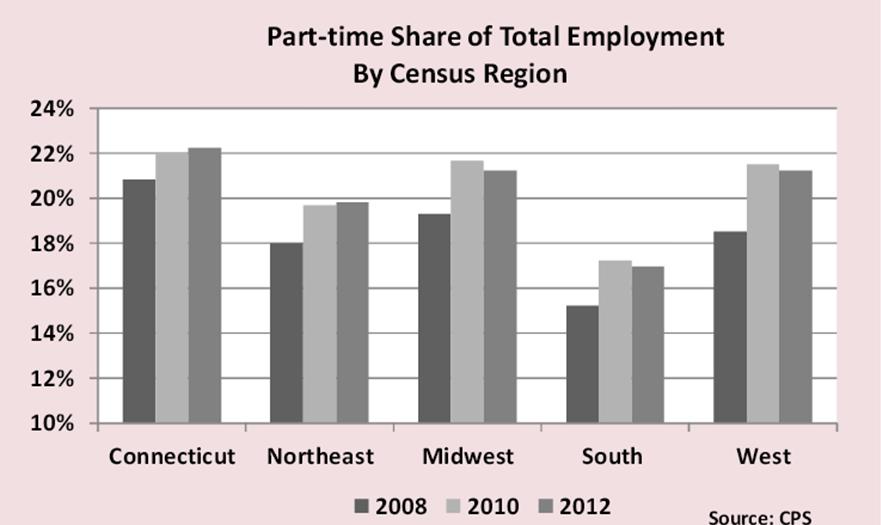
 zed Cities that were ranked, New Haven ranked #42 (up from #65 last year) and Bridgeport-Norwalk-Stamford
zed Cities that were ranked, New Haven ranked #42 (up from #65 last year) and Bridgeport-Norwalk-Stamford ranked at #58 (up from #85 last year) and saw the 10th largest advance among the medium sized cities.
ranked at #58 (up from #85 last year) and saw the 10th largest advance among the medium sized cities.
 reg Fischer, U.S. Labor Secretary Thomas Perez and Wendy Spencer, CEO of the Corporation for National and Community Service.
reg Fischer, U.S. Labor Secretary Thomas Perez and Wendy Spencer, CEO of the Corporation for National and Community Service. The Kid’s Marathon Program is designed to target city youth lacking in physical activity and good nutrition habits. Students run 1-2 miles, two or three times per week, completing a cumulative 26.2 mile marathon over the course of the program. They also receive positive and practical guidance on nutrition that helps foster long-term healthy eating behaviors. In 2013, the program’s first year, 438 students participated, with the culminating 1-mile run occurring at Crosby High School before a crowd of family, friends and supporters.
The Kid’s Marathon Program is designed to target city youth lacking in physical activity and good nutrition habits. Students run 1-2 miles, two or three times per week, completing a cumulative 26.2 mile marathon over the course of the program. They also receive positive and practical guidance on nutrition that helps foster long-term healthy eating behaviors. In 2013, the program’s first year, 438 students participated, with the culminating 1-mile run occurring at Crosby High School before a crowd of family, friends and supporters. e Association (ABA), to support and/or enhance mayors’ ongoing childhood obesity prevention programs in their cities. A total of $445,000 in grants was awarded to support both new and existing programs. Denver, CO and Dallas, TX (large cities) and York, PA and Monrovia, CA (small cities) were the other recipients.
e Association (ABA), to support and/or enhance mayors’ ongoing childhood obesity prevention programs in their cities. A total of $445,000 in grants was awarded to support both new and existing programs. Denver, CO and Dallas, TX (large cities) and York, PA and Monrovia, CA (small cities) were the other recipients.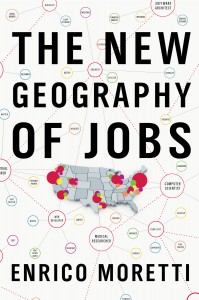 Francisco-Oakland (44%), Fort Collins-Loveland, Colorado (44%), and Seattle-Everett, Washington (42%). Yuma, AZ and Merced, CA, both at 11 percent, ranked last.
Francisco-Oakland (44%), Fort Collins-Loveland, Colorado (44%), and Seattle-Everett, Washington (42%). Yuma, AZ and Merced, CA, both at 11 percent, ranked last. education rise by about 7 percent as the share of college graduates in his city increases by 10 percent,” a statistical analysis indicates.
education rise by about 7 percent as the share of college graduates in his city increases by 10 percent,” a statistical analysis indicates.